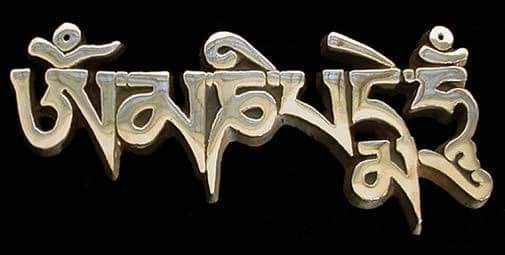The Benefits of the Mani Mantra

The mantra known as the Mani mantra, OM MANI PADME HUM (OM MANI PEME HUNG), is perhaps one of the best known and most used mantras of our time. It is the mantra of Avalokiteshvara (Chenrayzee), the Buddha of compassion. His Holiness the 14th Dalai Lama recommended that this mantra be recited during the covid 19 pandemic.
This mantra, also known as the Six Syllable Mantra, is said to be of incalculable benefit. In the Treasure of Compassion, His Eminence Asanga Vajra Rinpoche quotes Shakyamuni Buddha as saying that while there are many incredible things that he could count, he, the Buddha, could not count the many benefits of reciting the Mani mantra just one time. The Buddha gives many examples, saying things like, “I can count each snow flake, every blade of grass, and every leaf in the entire world, but I cannot count the merit of reciting the mantra OM MANI PADME HUM just one time.”
Lama Zopa has taught that you collect greater merit from reciting OM MANI PADME HUM than from actually offering service to countless Buddhas. Lama also adds that if you recite ten malas (10 times 108) of OM MANI PADME HUM every day, the negative karma of anybody who sees you is purified, and those people won’t be reborn in the lower realms. It’s the same when you touch anybody, for example if you shake their hand. It also has the power to purify the negative karma of anybody who hears your voice. It even blesses insects that land on your body.
In The Mirror Clarifying History, it says that this six-syllable mantra is the heart of the 84,000 teachings taught by Buddha. Even just seeing the Mani mantra written imparts great benefit.
Songtsen Gampo, an embodiment of Chenrezig, wrote a text called Mani Kabum, (One Hundred Thousand Teachings of the Mani). He says that chanting the Mani mantra is the same as chanting the mantras of all the Buddhas. So, by reciting it, we get the benefit of having chanted all the rest of the Buddhas’ mantras. It is said that if we chant the Mani mantra, at the time of death, Chenrezig will stretch out his hand to guide us to the pure land.
In Treasury of Compassion, Guru Padmasambhava, is quoted as saying that even a small insect, if it were to hear the sounds of the mantra just before dying, would be liberated from that body and be born in the pure land of Amitabha. Also he said that the virtues of the Six Syllables are immeasurable and cannot be fully described even by the Buddha’s of the three times.
Sometimes people ask what the translation of the mantra is. The translation of Sanskrit mantras is a rather limited way of trying to understand the meaning of a particular mantra. The Mani mantra has been translated in different ways, but a simple form might be, “The jewel in the lotus.”
The syllable OM is composed of three letters: A,U, and M. They symbolize the transformation of the reciter’s impure body, speech, and mind into the pure body, speech, and mind of a fully enlightened Buddha.
MANI PADME, show how this is accomplished.
MANI, which means jewel, indicates the method of altruism, compassion, and loving kindness.
PADME, which means lotus, indicates wisdom. There are many kinds of wisdom, but
the main one is the wisdom realizing emptiness, or the lack of inherent existence of self and others.
HUM has many meanings, but here, one of the meanings refers to the indivisibility of method and wisdom together.
So, in a very limited way, we could summarize the meaning of the mantra by saying that by practicing the path of the union of method and wisdom, impure body, speech, and mind are transformed into the pure body, speech, and mind of a fully enlightened Buddha. Many great teachers have gone into much greater detail explaining the meanings and benefits of this special mantra.
“I can count each snow flake, every blade of grass, and every leaf in the entire world, but I cannot count the merit of reciting the mantra OM MANI PADME HUM just one time…So recite the six syllables.” -Shakyamuni Buddha
“One of the most important features of this practice is that the mantra employed in the sadhana is extremely powerful. So powerful, in fact, that merely by hearing its words, “Om Mani Padme Hum,” a beginning has been formed, the connection and continuation of which will result in the eventual realization of buddhahood, if not in this current lifetime, then in a future existence.” -Kalu Rinpoche
“By contrast, there is a yidam practice- Chenrezi, or the Buddha of compassion-that is not as restrictive and can be done easily in daily life. In general, I think it is the best practice because it is both easy and very beneficial; this is why I have taught it in centers all over the world.” -Kalu Rinpoche
“There is not a single aspect of the eighty-four thousand sections of the Buddha’s teachings which is not contained in Avalokiteshvara’s six syllable mantra “Om Mani Padme Hum”, and as such the qualities of the “Mani” are praised again and again in the Sutras and Tantras…” -Dilgo Khyentse Rinpoche
“The syllables of Avalokiteshvara’s mantra, even when written by a an ordinary human hand, are not ordinary syllables, but have been consecrated by Avalokiteshvara’s wisdom mind. These syllables are made of his blessings; they have the power to liberate” -Dilgo Khyentse Rinpoche
“When you recite 1000 Mani mantras every morning, and other sentient beings see you, their negative karma will be purified.” -Lama Zopa
“The Mani mantra is the mantra of Chenrayzee. Most people think its benefits are limited to the next life, but actually it is beneficial for both this life as well as all following lives.” -H.E. Luding Khenchen Rinpoche
All content is the sole property of Ngakpa Jigdal Chopel ©, All Rights Reserved